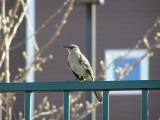Do You Hear What I Hear?
“Dad, is that a fire truck?” Megan asks as she rushes to the window.
Megan’s dad joins her. “It sure sounds like one. Can you see it?”
Megan looks up and down the street in front of her house, then shakes her head. “No, but if it’s not a fire truck, what is it?”
“I’ve got an idea, Megan. Come outside with me.” Megan’s dad opens the door and they step out. “Oh, there it is,” Dad says, pointing. “Do you see that grey bird in our mulberry tree? It’s the fire truck.”
“Oh, I see it.” Megan laughs. “It sounds just like a siren.”
* * *
The bird in Megan’s front yard is a Northern mockingbird. It has a special talent – copying different sounds. Some people think they hear a dog’s bark or a cat’s meow, but it’s the mockingbird copying animal noises it’s heard. Mockingbirds can even sound like squeaking gates, pianos, peeping frogs, chirping crickets, and sirens – like the one Megan heard.
Mockingbirds also imitate other birds and combine different birdsongs to create their own music. Some of the birds they copy are orioles, killdeer, jays, hawks, blackbirds, thrushes, and gulls. Scientists recorded the sounds of one mockingbird in South Carolina and identified thirty-two different kinds of birdsongs in just ten minutes.
You can see northern mockingbirds in Mexico and Canada. They also live all over the United States. As a matter of fact, the mockingbird is the state bird of Florida, Tennessee, Mississippi, Arkansas, and Texas. Mockingbirds are common in cities, suburbs, parks, open land, and at the edge of forests. You may even see them in your own yard.
So, the next time you think you hear a fire truck, it just might be the Northern mockingbird adding a siren to its song.
Bibliography
Breitmeyer, Eve. “Mimus Polyglottos Northern Mockingbird.” Animal Diversity Web.
University of Michigan, Museum of Zoology. Accessed November 14, 2012. http://
animaldiversity.umich.edu/accounts/Mimus_polyglottos/.
Brown, Agustus. Why Panda do Handstands: And Other Curious Truths About Animals. New
York: Free Press. 2006.
“Mimus Polyglottos Northern Mockingbird.” Encyclopedia of Life. Accessed November 14, 2012. http://eol.org/pages/1050704/overview.
“Northern Mockingbird.” All About Birds. The Cornell Lab of Ornithology. Accessed November
13, 2012. http://www.allaboutbirds.org/guide/Northern_Mockingbird/id.
“Northern Mockingbird.” All About Birds. The Cornell Lab of Ornithology. Accessed November 14, 2012. http://www.allaboutbirds.org/guide/Northern_Mockingbird/lifehistory.
“Northern Mockingbird.” All About Birds. The Cornell Lab of Ornithology. Accessed November 14, 2012. http://www.allaboutbirds.org/guide/Northern_Mockingbird/sounds.
“Northern Mockingbird.” National Geographic. Accessed November 13, 2012. http://animals.
nationalgeographic.com/animals/birding/northern-mockingbird/.
“The Northern Mockingbird Habits.” Wild Bird Watching Where Bird Watchers Find Answers.
Accessed November 13, 2012. http://www.wild-bird-watching.com/Mockingbird.htm.
 Pamela Harrison, a former elementary teacher, loves writing for children. She started writing stories for her own children when they were young. As a teacher, she liked to included literature in all subjects, and when she couldn’t find a story to use, she wrote her own.
Pamela Harrison, a former elementary teacher, loves writing for children. She started writing stories for her own children when they were young. As a teacher, she liked to included literature in all subjects, and when she couldn’t find a story to use, she wrote her own.





